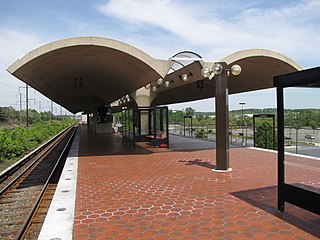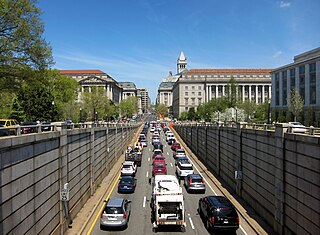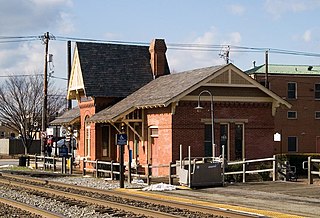
The Capitol Limited is a daily Amtrak train between Washington, D.C., and Chicago, running 764 miles (1,230 km) via Pittsburgh and Cleveland. Service began in 1981 and was named after the Baltimore and Ohio Railroad's Capitol Limited which ended in 1971 upon the formation of Amtrak. It carries the Amtrak train numbers 29 and 30, which were previously assigned to the discontinued National Limited.

MARC is a commuter rail system in the Washington–Baltimore area. MARC is administered by the Maryland Transit Administration (MTA) and operated under contract by Alstom and Amtrak on track owned by CSX Transportation (CSXT) and Amtrak. In 2023, the system had a ridership of 3,860,600, or about 10,800 per weekday as of the first quarter of 2024, less than pre-COVID-19 pandemic weekday ridership of 40,000.

The Red Line is a rapid transit line of the Washington Metro system, consisting of 27 stations in Montgomery County, Maryland, and Washington, D.C., in the United States. It is a primary line through downtown Washington and the oldest and busiest line in the system. It forms a long, narrow "U," capped by its terminal stations at Shady Grove and Glenmont.

Takoma station is a Washington Metro station on the Red Line in the Takoma neighborhood of Washington, D.C., bordering Takoma Park, Maryland. The station is considered to be located in part of Takoma Park's Historic District. It is the last station in the District of Columbia on the eastern end of the Red Line heading to Maryland, located east of the intersection of Blair Road NW and Cedar Street NW. The station's parking lot and bus stops are accessed from Eastern Avenue NW, which runs along the DC–Maryland line.

Franconia–Springfield station is a Washington Metro rapid transit station and Virginia Railway Express commuter rail station located in Springfield, Virginia, United States. The station is the southwestern terminus of the Metro Blue Line and an intermediate station on the VRE Fredericksburg Line. It is also a major bus terminal for Fairfax Connector buses, plus other local and intercity bus routes. The station has one island-platform serving the two Metro tracks, plus two side platforms serving the RF&P Subdivision on which the Fredericksburg Line runs.

Landover station is an island-platformed Washington Metro station in Landover, Maryland, United States. The station was opened on November 20, 1978, and is operated by the Washington Metropolitan Area Transit Authority (WMATA). Providing service for the Orange Line, the station is in a residential area of Landover at Pennsy Drive near Landover Road. It is primarily a commuter station, with parking for over 1,800 cars, but it also served the now-demolished Capital Centre, the former home of the Washington Bullets and Washington Capitals.

New Carrollton station is a joint Washington Metro, MARC, and Amtrak station just outside the city limits of New Carrollton, Prince George's County, Maryland located at the eastern end of the Metro's Orange Line. The station will also serve as the eastern terminus of the Purple Line, currently under construction, and is adjacent to the Capital Beltway.

Washington, D.C. has a number of different modes of transportation available for use. Commuters have a major influence on travel patterns, with only 28% of people employed in Washington, D.C. commuting from within the city, whereas 33.5% commute from the nearby Maryland suburbs, 22.7% from Northern Virginia, and the rest from Washington, D.C.'s outlying suburbs.

Aberdeen station is a train station in Aberdeen, Maryland, on the Northeast Corridor. It is served by Amtrak Northeast Regional intercity service and MARC Penn Line commuter service. The station has two side platforms serving the outer tracks of the three-track Northeast Corridor, with a station building on the north side of the tracks.

The Brunswick Line is a MARC commuter rail line between Washington, D.C., and Martinsburg, West Virginia, with a branch to Frederick, Maryland. It primarily serves the northern and western suburbs of Washington. The line, MARC's second longest at 74 miles, is operated under contract to MARC by Alstom and runs on CSX-owned track, including the Metropolitan, Old Main Line, and Cumberland subdivisions. It is the successor to commuter services provided by the Baltimore & Ohio Railroad (B&O), which date to the mid-19th century.

The CSX Cumberland Subdivision is a railroad line owned and operated by CSX Transportation in the U.S. states of Maryland and West Virginia. The line runs from Brunswick, Maryland, west to Cumberland, Maryland, along the old Baltimore and Ohio Rail Road (B&O) main line. At its east end, the Cumberland Subdivision becomes the Metropolitan Subdivision; at its west end at Cumberland, Maryland it becomes the Cumberland Terminal Subdivision. It meets the Shenandoah Subdivision at Harpers Ferry, West Virginia, and the Lurgan Subdivision in Cherry Run, West Virginia.

Martinsburg station is a railway station in Martinsburg, West Virginia, United States, served by MARC Brunswick Line commuter rail service and Amtrak Capitol Limited intercity rail service. The station has one side platform serving a siding track of the CSX Cumberland Subdivision, with a footbridge crossing the siding and the two main tracks to provide access to the preserved Baltimore and Ohio Railroad Martinsburg Shops complex.

Gaithersburg station is a commuter rail station located on the Metropolitan Subdivision in downtown Gaithersburg, Maryland. It is served by the MARC Brunswick Line service; it was also served by Amtrak from 1971 to 1986. The former Baltimore and Ohio Railroad station building and freight shed, designed by Ephraim Francis Baldwin and built in 1884, are listed on the National Register of Historic Places as Gaithersburg B & O Railroad Station and Freight Shed. They are used as the Gaithersburg Community Museum.

Barnesville is an active commuter railroad train station in Barnesville, Montgomery County, Maryland. Located on Beallsville Road, Barnesville station services trains of MARC Train's Brunswick Line between Union Station in Washington D.C. and Martinsburg, West Virginia. Additional trains operate to Frederick, Maryland. Amtrak's Capitol Limited operates through the station, but does not make any stops. The next station west is Dickerson while the next station east is Boyds. Barnesville station contains two low-level side platforms, connected by a pathway across the tracks.

Brunswick is a passenger rail station on the MARC Brunswick Line between Washington, D.C., and Martinsburg, West Virginia. The station house, located at 100 South Maple Street in Brunswick, Maryland, is a former Baltimore and Ohio Railroad depot that is a contributing property to the Brunswick Historic District, which has been listed on the National Register of Historic Places since August 29, 1979. The station was designed by Ephraim Francis Baldwin and opened in 1891 on Seventh Avenue. Several years later the building was moved to its current location. It is a wooden frame building with stone walls up to the window sills, and features Palladian windows in the roof dormers.

The Bowie Railroad Buildings comprise three small frame structures at the former Bowie train station, located at the junction of what is now the Northeast Corridor and the Pope's Creek Subdivision in the town center of Bowie, Maryland. The complex includes a single-story freight depot, a two-story interlocking tower, and an open passenger shed. The station was served by passenger trains from 1872 until 1989, when it was replaced by Bowie State station nearby. The buildings were restored in 1992 as the Bowie Railroad Museum and added to the National Register of Historic Places in 1998.

Silver Spring station is a former train station on the Metropolitan Subdivision in Silver Spring in Montgomery County, Maryland. It was built in 1945 by the Baltimore and Ohio Railroad on the foundation of a previous station, a Victorian-style brick structure built in 1878. It served intercity trains until 1986 and commuter rail until 2000. Today, it is owned and operated as a museum by Montgomery Preservation, Inc., a non-profit organization.

The West Virginian, later known as the Potomac Turbo and Potomac Special, was a daily passenger train operated by Amtrak between Washington, D.C., and Parkersburg, West Virginia. This route was previously served by the Baltimore & Ohio's (B&O) train of the same name, and was the first of several services in the state of West Virginia established at the behest of US Representative Harley Orrin Staggers, the powerful chair of the House Interstate and Foreign Commerce Committee. This patronage earned the train the derisive sobriquets "Harley's Hornet" and the "Staggers Special".

The Blue Ridge was a daily Amtrak passenger train that operated between Washington, D.C., and Cumberland, Maryland. Service began in 1973; it was merged into the MARC Brunswick Line commuter rail service in 1986.


























